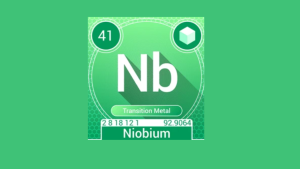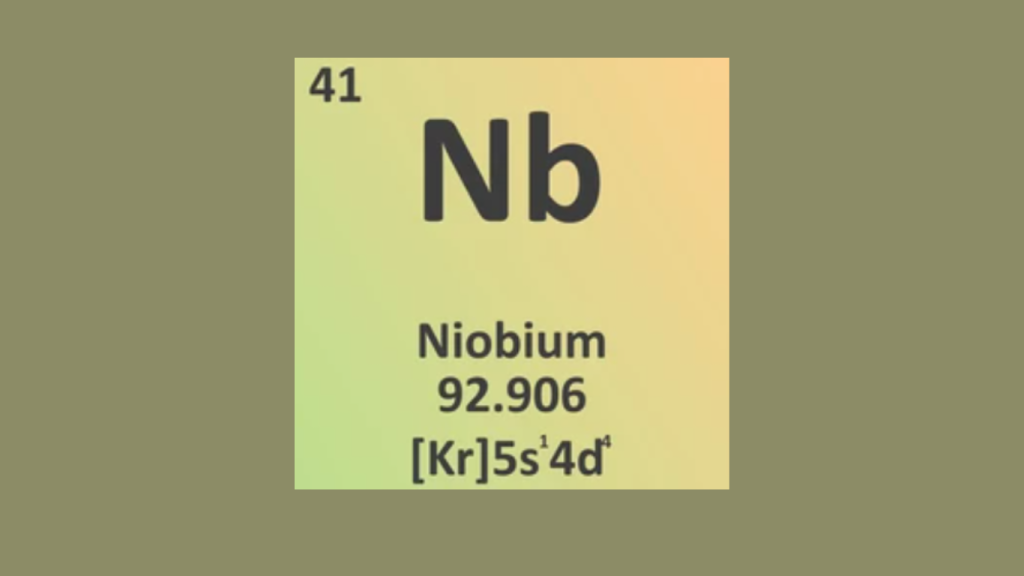Niobium electron configuration is [Kr] 4d4 5s1. This chemical element commonly presents itself as a grey, ductile, and shiny solid metal with a white sheen.
Niobium is found in minerals such as pyrochlore and columbite and has various industrial applications. It is often used in alloys, specifically to create high-strength, low-alloy steels and superconducting materials. Due to its resistance to corrosion and high melting point, niobium is also utilized in the aerospace, nuclear, and electronics industries.
This element has various intriguing properties, such as its ability to form superconducting compounds. We will explore niobium’s electron configuration and other essential properties.
What Is Niobium?
Niobium’s electron configuration is 1s2 2s2 2p6 3s2 3p6 3d10 4s2 4p6 4d4 5s1. It is a silvery metal with a high melting point, used in alloys to improve strength and heat resistance. Niobium is also found in superconducting magnets and electronic components.
Niobium, or columbium, is a chemical element with the symbol Nb and atomic number 41. It’s a soft, silvery-white metal that belongs to the group of refractory metals. Niobium is widely used in various applications, including alloys, superconducting materials, and electronic devices.
Properties And Characteristics
Niobium has a number of unique properties and characteristics, including:
- High melting point (2,468 °C)
- Low density (8.57 g/cm³)
- Good ductility and malleability
- Resistance to corrosion and oxidation
Niobium is also highly resistant to heat and wear and has a high superconducting transition temperature. In addition, it is non-toxic and has good biocompatibility, making it an ideal material for medical implants. One of the most notable characteristics of niobium is its electron configuration. Niobium has an electronic configuration of [Kr] 4d4 5s1, meaning that it has 41 electrons, with four electrons in the d orbital and one in the s orbital. This configuration gives niobium unique properties that make it useful in various applications.
In Conclusion
Niobium is an important element widely used in various industries. Its unique properties and characteristics make it ideal for a variety of applications. Whether you are looking for a material with a high melting point, low density, or resistance to corrosion and oxidation, niobium is certainly worth considering.
Niobium Electron Configuration Basics
The niobium atom has a complex electron configuration, with 41 electrons occupying various energy levels and orbitals around the nucleus. Specifically, the 4d and 5s orbitals are filled before the 4f and 5p orbitals.
Niobium Electron Configuration Basics Niobium is a chemical element with the symbol Nb and atomic number 41. It is a soft, grey, and ductile transition metal, and it’s often found in combination with tantalum in minerals. The electronic configuration of niobium is the arrangement of electrons in its atoms, and it can be represented using subshells. The niobium electron configuration basics include its location on the periodic table, the number of valence electrons, and its electron configuration notation, which we’ll discuss in this blog post. Location on the Periodic Table Niobium is located in the fifth row, group 5, of the periodic table, alongside elements such as vanadium, chromium, and manganese. It’s part of the transition metals group, which includes elements that are commonly used in industry, technology, and manufacturing. Niobium is a relatively rare element, and it’s primarily found in minerals such as columbite and pyrochlore, which are typically mined in Brazil and Canada. Valence Electrons Valence electrons refer to the electrons situated in the outermost shell of an atom, and these electrons are responsible for chemical reactions and interactions with other elements. Niobium has a total of 41 electrons, with 14 of these electrons situated in the 4d subshell and one electron in the 5s subshell. The remaining 12 electrons are in the 5p subshell, with three valence electrons. This configuration makes niobium reactive with other elements, particularly transition metals. Electron Configuration Notation The electron configuration notation of niobium is [Kr] 4d^4 5s^1. The notation represents electrons in subshells, with values that are determined by the quantum numbers. The first part of the notation [Kr] is the noble gas core notation, which shows the electron configuration of the noble gas that precedes niobium on the periodic table. In this case, niobium follows krypton, and so its electronic configuration begins with the krypton fully occupied shell. To summarize, niobium is a transition metal with the symbol Nb and atomic number 41. It’s located in the fifth row, group 5, of the periodic table, with three valence electrons in its outermost shell. The niobium electron configuration notation is [Kr] 4d^4 5s^1. Now that we’ve covered the basics, we’ll delve deeper into the significance of niobium’s electron configuration in our upcoming posts.
How To Determine The Electron Configuration Of Niobium?
The electron configuration of Niobium can be determined by using the order of filling orbitals in an atom. Niobium has a total of 41 electrons, and they are arranged in shells and subshells according to their energy levels. The final configuration of Nb is [Kr] 4d4 5s1.
Niobium, with the atomic number 41, is a chemical element that belongs to Group 5 of the periodic table. Understanding the electron configuration of niobium is crucial for its in-depth study. The electron configuration of an atom is the arrangement of electrons in an atom’s orbitals.
Aufbau Principle
The Aufbau principle is a concept that explains the order in which electrons fill the subshells or orbitals. According to the Aufbau principle, electrons fill orbitals from the lowest energy level to the highest energy level. The electron configuration of niobium using the Aufbau principle can be calculated as follows:
- 1s22s22p63s23p64s23d10
- 4p6
- 5s1
- 4d4
Thus, the electron configuration of niobium is [Kr] 4d^4 5s^1.
Pauli Exclusion Principle
The Pauli exclusion principle states that no two electrons in an atom can have the same set of four quantum numbers. Therefore, each orbital can contain a maximum of two electrons with opposite spins. This principle plays a crucial role in determining the electron configuration of niobium.
Hund’s Rule
Hund’s rule is a principle that states that electrons must fill each subshell with one electron before pairing. In other words, each orbital in a subshell must contain one electron before a second electron can pair up in the same orbital. This rule ensures that each electron in an atom has maximum unpaired spins. Therefore, by using the Aufbau principle, Pauli exclusion principle, and Hund’s rule, we can determine the electron configuration of niobium, which is [Kr] 4d^4 5s^1.
Niobium Electron Configuration Notation
Niobium has an electron configuration notation of [Kr] 4d4 5s1. This means that in its ground state, niobium has a total of 41 electrons distributed among its atomic orbitals, with the majority of them in the 4d orbital.
Niobium is a chemical element with the symbol Nb and atomic number 41. It is a soft, grey, ductile metal that is often used in alloys. Its electron configuration notation is an essential aspect of the element’s characteristics. The notation describes the energy levels and orbitals of the electrons in an atom of niobium. There are two types of niobium electron configuration notation: simplified and complete. In this blog post, we will delve into niobium electron configuration notation and explore the differences between the two types.
Simplified Notation
41. This notation is a shortened version of the complete niobium electron configuration, which we will discuss shortly. The [Kr] represents the electron configuration of krypton, which is the noble gas that comes before niobium in the periodic table. The 4d41 represents the number of electrons in each energy level and orbital.
Complete Notation
22626102641. This notation gives the exact energy levels and orbitals of all the electrons present in a niobium atom. As we can see, the simplified notation is a shorter way of representing the complete notation, leaving out the noble gas that comes before it in the periodic table and the electrons in the previous energy levels. In conclusion, the niobium electron configuration notation describes the distribution of electrons among different atomic orbitals and energy levels. It is an essential aspect of the element’s characteristics since the behavior of an atom depends on the number and arrangement of its electrons. Simplified and complete notations are two types of niobium electron configuration notation, each providing different levels of detail about the element’s electron configuration.

Applications Of Niobium
Niobium’s electron configuration makes it useful in many applications, such as superconductivity, electronics, and alloys. Its stable configuration makes it ideal for use in high-temperature and high-stress environments.
Niobium is a versatile and valuable metal with various applications in different industries. This section will examine how niobium is used in these industries.
Industrial Uses
Niobium has several industrial uses due to its unique properties. Some of the most notable industrial applications of niobium are:
- Superalloys: Niobium is commonly alloyed with other metals like iron, nickel, and cobalt to make superalloys that are used in the aerospace and aviation industries. These superalloys are used to make turbine blades, exhaust nozzles, and other high-temperature parts of aircraft engines.
- Steel production: Niobium is also added to steel in small amounts to improve its strength, durability, and weldability properties. This makes niobium a valuable material for the construction industry, where high-strength steel is often required.
- Electronics: Niobium is used to make capacitor anodes that are used in electronic devices such as cellular phones, computers, and televisions. These anodes allow for higher capacitance and lower ESR (Equivalent Series Resistance) than materials like tantalum or aluminum.
Other Uses
Apart from its industrial uses, niobium also has other valuable uses in different fields, such as:
- Medical implants: Niobium is inert and highly biocompatible, making it ideal for medical implants such as dental implants, pacemaker electrodes, and bone replacements.
- Jewelry: Niobium is used in jewelry-making because it is lightweight, hypoallergenic, and highly resistant to tarnishing. Niobium jewelry is known for its unique coloring properties, as the metal can be anodized, changing into different colors according to the voltage applied during anodizing.
- Nuclear reactors: Niobium is used to make reactor vessels and fuel cladding in nuclear reactors due to its resistance to high-temperature and corrosion resistance properties.
In conclusion, niobium is an important and versatile metal that has several industrial and other applications. With its unique properties and compelling benefits, niobium will remain an essential part of many industries.
Frequently Asked Questions Of Niobium Electron Configuration
How Do You Write The Electron Configuration For Niobium?
The electron configuration for niobium is 1s² 2s²p⁶ 3s²p⁶d¹⁰ 4s²p⁶d⁴ 5s¹.
Why Is Niobium 4d4 5s1 Electron Configuration?
Niobium’s electron configuration is 4d4 5s1 because the 4d orbital has a lower energy level than the 5s orbital. Electrons fill the lower energy level first before moving to the higher one, so the 4d orbital is filled before the 5s orbital.
What Is The Electron Configuration Of 41?
The electron configuration of 41, which represents the element niobium (Nb), is [Kr]5s24d3.
Which Atom Has The Electron Configuration 1s22s2 2p6 3s2 3p4?
The atom with the electron configuration 1s22s2 2p6 3s2 3p4 is sulfur.
Conclusion
The study of Niobium Electron Configuration is fascinating and important for understanding the properties of this metal. By knowing the electron configuration, we can predict how niobium will react with other elements and how to utilize its unique properties. Whether it’s in the industry, technology or science world, the knowledge of niobium electron configuration can be paramount.
Understanding this metal’s electron configuration is vital for developing new materials and more efficient machines. Make sure to employ your knowledge of niobium’s electron configuration practically.
